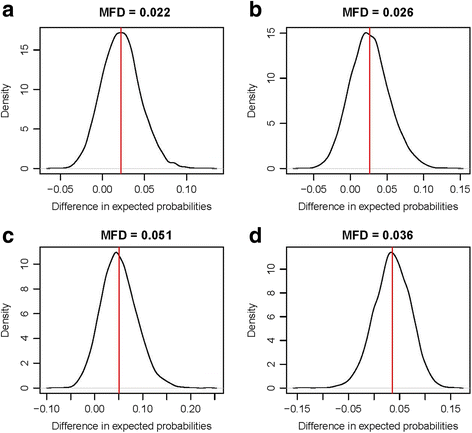Health system strategies to increase HIV screening among pregnant women in Mesoamerica
- PMID: 29554930
- PMCID: PMC5859704
- DOI: 10.1186/s12963-018-0162-8
Health system strategies to increase HIV screening among pregnant women in Mesoamerica
Abstract
Background: To propose health system strategies to meeting the World Health Organization (WHO) recommendations on HIV screening through antenatal care (ANC) services, we assessed predictors of HIV screening, and simulated the impact of changes in these predictors on the probability of HIV screening in Guatemala, Honduras, Mexico (State of Chiapas), Nicaragua, Panama, and El Salvador.
Methods: We interviewed a representative sample of women of reproductive age from the poorest Mesoamerican areas on ANC services, including HIV screening. We used a multivariate logistic regression model to examine correlates of HIV screening. First differences in expected probabilities of HIV screening were simulated for health system correlates that were associated with HIV screening.
Results: Overall, 40.7% of women were screened for HIV during their last pregnancy through ANC. This rate was highest in El Salvador and lowest in Guatemala. The probability of HIV screening increased with education, household expenditure, the number of ANC visits, and the type of health care attendant of ANC visits. If all women were to be attended by a nurse, or a physician, and were to receive at least four ANC visits, the probability of HIV screening would increase by 12.5% to reach 45.8%.
Conclusions: To meet WHO's recommendations for HIV screening, special attention should be given to the poorest and least educated women to ensure health equity and progress toward an HIV-free generation. In parallel, health systems should be strengthened in terms of testing and human resources to ensure that every pregnant woman gets screened for HIV. A 12.5% increase in HIV screening would require a minimum of four ANC visits and an appropriate professional attendance of these visits.
Keywords: Antenatal care; Central America; HIV screening; Health care disparities; Human immunodeficiency virus; Mesoamerica.
Conflict of interest statement
Competing interest
Authors declare that no competing interests exist.
Ethics approval and consent to participate
The study received institutional review board approval from the University of Washington, partnering data collection agencies, and the Ministry of Health in each country. Participants were asked to sign a written consent form prior to taking part in the study.
Consent for publication
Not applicable.
Publisher’s Note
Springer Nature remains neutral with regard to jurisdictional claims in published maps and institutional affiliations.
Figures

Similar articles
-
Antenatal care as a means to increase participation in the continuum of maternal and child healthcare: an analysis of the poorest regions of four Mesoamérican countries.BMC Pregnancy Childbirth. 2019 Feb 12;19(1):66. doi: 10.1186/s12884-019-2207-9. BMC Pregnancy Childbirth. 2019. PMID: 30755183 Free PMC article.
-
Coverage and timing of antenatal care among poor women in 6 Mesoamerican countries.BMC Pregnancy Childbirth. 2016 Aug 19;16:234. doi: 10.1186/s12884-016-1018-5. BMC Pregnancy Childbirth. 2016. PMID: 27542909 Free PMC article.
-
Planning for the next generation.People Planet. 1992;1(3):24-5. People Planet. 1992. PMID: 12317703
-
Quality assessment indicators in antenatal care worldwide: a systematic review.Int J Qual Health Care. 2019 Aug 1;31(7):497-505. doi: 10.1093/intqhc/mzy206. Int J Qual Health Care. 2019. PMID: 30295805
-
Legal considerations in screening pregnant women for human immunodeficiency virus.Am J Obstet Gynecol. 1999 Feb;180(2 Pt 1):259-64. doi: 10.1016/s0002-9378(99)70197-3. Am J Obstet Gynecol. 1999. PMID: 9988784 Review.
Cited by
-
Guidance for Triangulating Data and Estimates of HIV Prevalence Among Pregnant Women and Coverage of PMTCT Using the Spectrum AIDS Impact Module.J Acquir Immune Defic Syndr. 2024 Dec 15;97(5):439-449. doi: 10.1097/QAI.0000000000003514. Epub 2024 Nov 5. J Acquir Immune Defic Syndr. 2024. PMID: 39187933 Free PMC article.
References
-
- Lozano R, Gómez-Dantés H, Castro MV, Franco-Marina F, Santos-Preciado JI. Progress on the Millenium development goals 4 and 5 in Mesoamerica. Salud Publica Mex. 2011;53(Suppl 3):S295–S302. - PubMed
-
- Franco-Paredes C, Hernández-Ramos I, Santos-Preciado JI, Grupo de Trabajo en Inmunizaciones del Sistema Mesoamericano de Salud Pública Immunization and equity in the regional initiative of the Mesoamerican health initiative. Salud Publica Mex. 2011;53(Suppl 3):S323–S332. - PubMed
-
- Interamerican Development Bank . Mesoamerican health initiative: immunization master plan. 2009.
-
- USAID . Program implementation guidance: essential obstetric and newborn care. 2012.
Publication types
MeSH terms
LinkOut - more resources
Full Text Sources
Other Literature Sources
Medical

